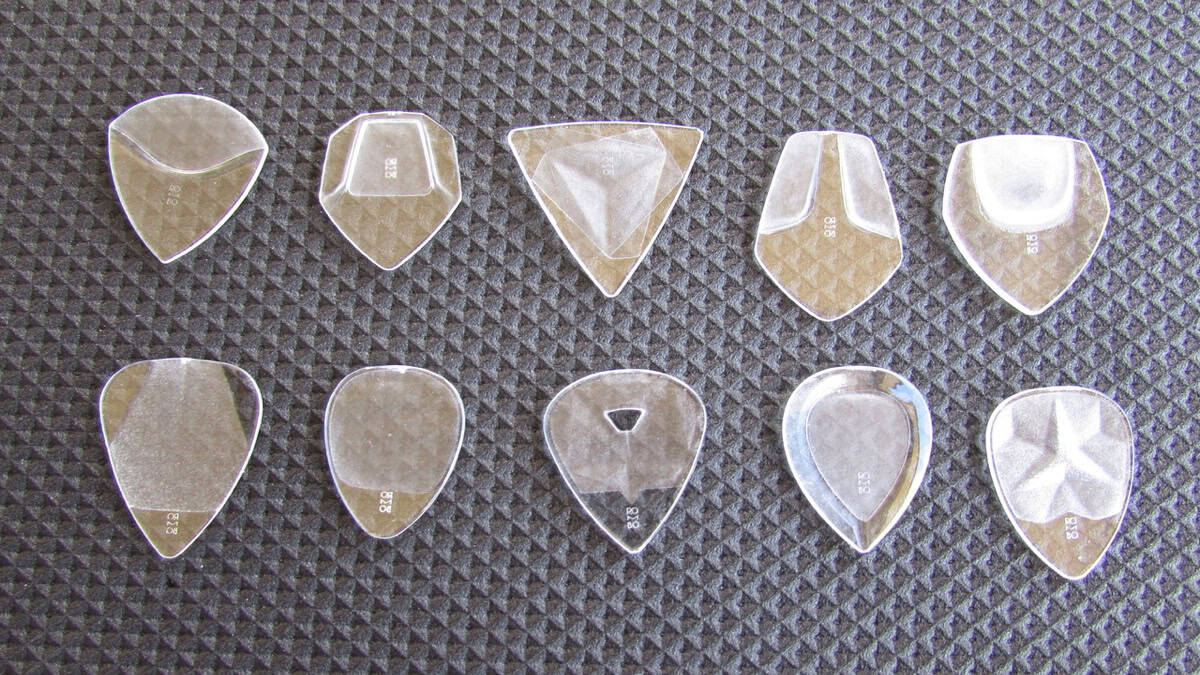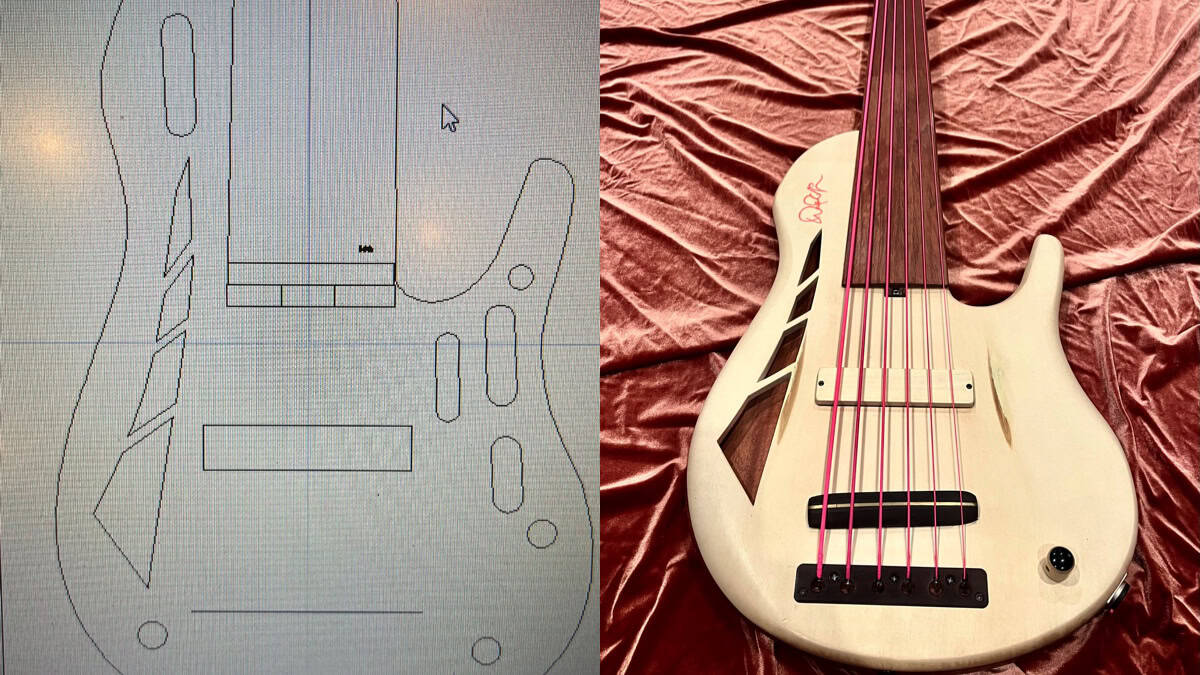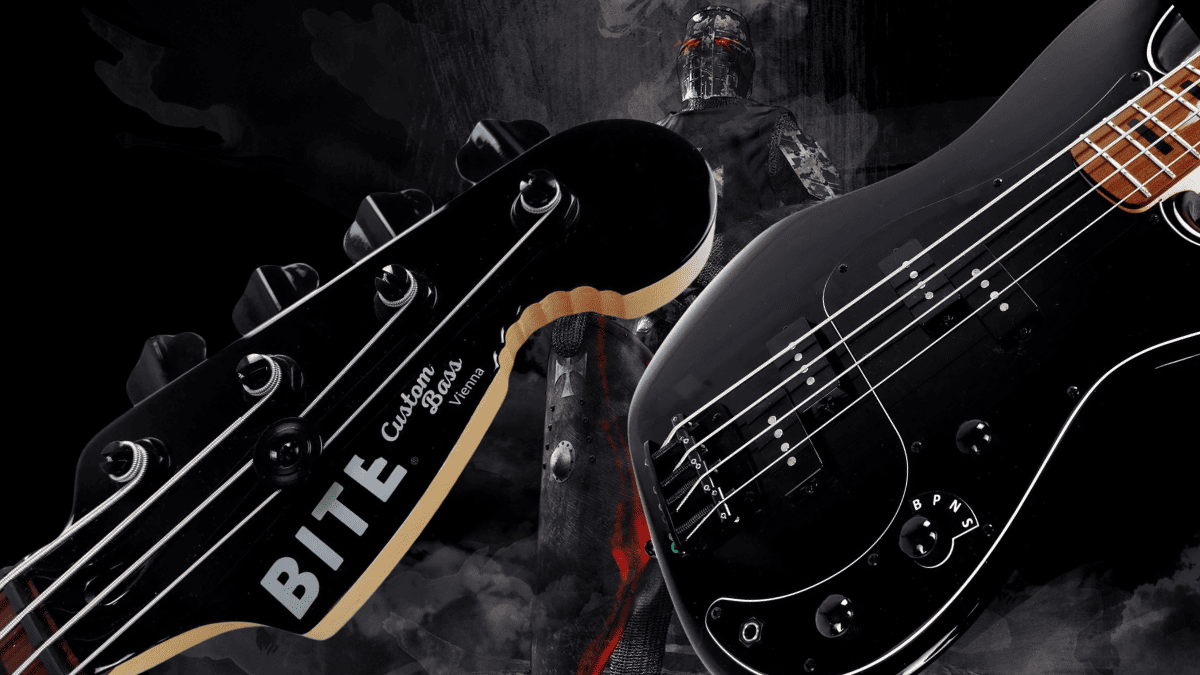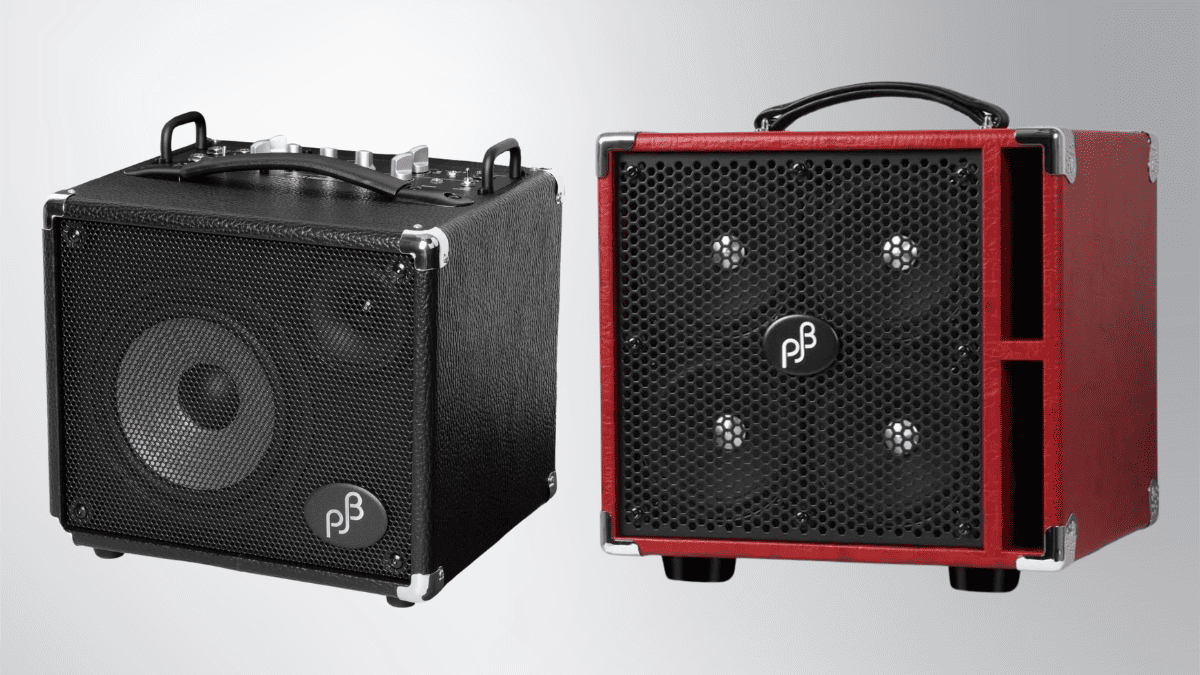Gear Reviews
Gear Impressions and Luthier Spotlight With Jake Wolf: Erizias Singlecut 5 String

 Review by Jake Wolf
Review by Jake Wolf
Email Jake | Read More Reviews
I must admit, when it comes to the custom bass biz, I’m always leery of the new guy. Sure their stuff looks great, but how does it stack against the tried-and-true the industry benchmarks? Is it just another pretty face, or does it deliver the goods? When I approached the inconspicuous Erizias booth at NAMM (after several friends’ raving recommendations) I was immediately impressed by what I consider to be one of the most elegant singlecut designs out there. My first thought was “WOW! Those look amazing!” Then came the cynical “yeah but… how does it sound? How does it play? It’s probably another beautiful piece of lumber that plays and sounds like you know what.” Pierre Erizias greeted me with a warm smile and immediately let the bass speak for itself by plopping it in my lap. Within minutes I was sold. Answer: yep, this is the real deal. Pierre’s singlecut made my (and many others’) all-stars list for Winter NAMM ’09, and I couldn’t wait to spend some quality time reviewing and testing one of his delicious basses. As it turns out, he sent me the same bass I came to adore from NAMM, and several months later, my initial impression was correct; this thing is a beast.
Erizias chose Nordstrand’s dual coil pickups for this bass, and paired it with a Glockenklang 3 band preamp, a combination that allows the bass to sound as good as it looks in my opinion. A removable bird’s eye maple ramp between the pickups gives players the choice of utilizing a playing ramp; a feature that more and more bassists are finding improves their technique and comfort. The Asymmetrical neck took a second for me to get used to, due to its thickness on the bass side, but I quickly adjusted and found it comfortable and solid feeling. Access to the highest frets was effortless, and the bass balanced perfectly in my lap. It was clear from the get-go that Erizias is a player. From the minute I picked this bass up, it felt perfectly balanced, and was super comfortable to play.
I took the Erizias to a variety of gigs and it quickly became a go-to for its warmth and richness. Plugged in with the preamp bypassed and with a fresh set of DR sunbeams, the bass had a thick, full voice with abundant depth and midrange complexity, yet didn’t sound bloated or muddy (as basses which possess those midrange characteristics sometimes do). The Erizias sounds warm and articulate, but not in the hi-fi zingy kind of way that many of us have come to identify as “articulate” (with a set of DR hi beams, it had much more going on in the upper mids and treble, but at no time did it sound clanky or brash). Its articulation lies more in the mid response of the bass, notes tended to fly off the fingerboard with authority and clarity. The Erizias retained its fullness above the 12th fret. Upper octave notes that on other instruments can sound thin or twangy sounded warm and clear on the Erizias, and chords rang true and well defined. The 35″ scale B string sounded massive and powerful, and blended well with the sound of the bass overall.
One cool ergonomic feature that sets the Erizias apart from the pack is the countersunk Hipshot A style bridge. By recessing the bridge into the body by a small amount, the string clearance over the body is lowered, which in combination with the playing ramp results in a streamlined playing surface. This is not for everyone, as some of my bass player buddies commented, but I really dug it. When I asked Erizias about the purpose of the countersunk bridge, he responded: “I wanted to simulate the string to body clearance from my ’77 jazz bass, and counter sinking the bridge achieves the proper height for that.”
The Glockenklang electronics were cleanly installed in the well shielded cavity; all the wiring looked tidy and clean. The Glock preamp offers great tonal flexibility, and plenty of noise free boost. Pulling up on the volume knob disengaged the preamp circuit, and I was happy to find that the sound was almost identical to the active setting with the eq flat. Often times, a preamp’s passive function is intended only as a battery failsafe, and not as a viable tonal option. It’ll get you through the gig, but it ain’t gonna sound great. I myself really like a usable passive setting, and the Glock allows you to bypass the pre and get a fantastic natural sound. Also, when the bass is in passive mode, the active treble control becomes a passive tone control. Cool!
The only shortcoming I detected on the bass was the finish used. Erizias used a water based lacquer for this instrument, and although it was sufficient and quite protective, it didn’t have the luster or 3d sheen I’ve come to love with gloss finishes. Erizias responded that since this bass was built, they have switched to a finish that they much prefer for its looks, maintenance, and durability.
All in all, I was very impressed with the Erizias. I will definitely be keeping an eye out for what comes next from the Erizias shop, and I’ll try harder not to be so judgmental of the new guy from now on, after all, I don’t want to eat my words again!
 Erizias pulled out all the stops and chose some seriously beautiful pieces of wood for this bass. It features a lightweight ash body topped with a gorgeous slab of buckeye burl. The sumptuous flame maple neck is connected to the body with 5 solid bolts, and features some unique high end touches. The rear of the headstock features an ash veneer. Understated and subtle for sure, but it looks super hip. Blue green abalone is abundantly inlayed on the Erizias, from the well executed blocks on the thick maple fingerboard, to the classy fleur de lis inlay on the back of the neck. It even has some sexy accent inlays on the face of the headstock that blend beautifully with the buckeye’s figuring.
Erizias pulled out all the stops and chose some seriously beautiful pieces of wood for this bass. It features a lightweight ash body topped with a gorgeous slab of buckeye burl. The sumptuous flame maple neck is connected to the body with 5 solid bolts, and features some unique high end touches. The rear of the headstock features an ash veneer. Understated and subtle for sure, but it looks super hip. Blue green abalone is abundantly inlayed on the Erizias, from the well executed blocks on the thick maple fingerboard, to the classy fleur de lis inlay on the back of the neck. It even has some sexy accent inlays on the face of the headstock that blend beautifully with the buckeye’s figuring.
For more info, visit Erizias online at: http://eriziasbasses.com/
Jake Wolf welcomes your comments and questions… drop him a line
Bass Videos
Review: CrystalBright Rombo Picks

CrystalBright Rombo Picks
PR SamplePlaying bass with a pick is still a touchy subject in our community. I believe you should be able to use whatever you need to get your sound. Even though I mostly play with my fingers, I like to check out innovative new picks that might have something new to offer, sonically speaking.
Judith and Carlos from Rombo recently contacted me about a new material called CrystalBright that they have been researching for the last 12 months and offered to send some prototype picks. After trying them out, I put together this video with my findings.
For more info check out @rombopicks
Gear
New Joe Dart Bass From Sterling By Music Man

Sterling by Music Man introduces the Joe Dart Artist Series Bass (“Joe Dart”), named after and designed in collaboration with the celebrated Vulfpeck bassist.
Above photo credit: JORDAN THIBEAUX
This highly-anticipated model marks the debut of the Dart bass in the Sterling by Music Man lineup, paying homage to the Ernie Ball Music Man original that all funk players know and love. The bass embodies many of the original model’s distinctive features, from its iconic minimalist design to the passive electronics.

The design process prioritized reliability, playability, and accessibility at the forefront. Constructed from the timeless Sterling body, the Dart features a slightly smaller neck profile, offering a clean tone within a comfortable package. The body is crafted from soft maple wood for clarity and warmth while the natural finish emphasizes the simple yet unique look.
Engineered for straightforward performance, this passive bass features a ceramic humbucking bridge pickup and a single ‘toaster’ knob for volume control. Reliable with a classic tone, it’s perfect for playing in the pocket. The Dart is strung with the all-new Ernie Ball Stainless Steel Flatwound Electric Bass Strings for the smoothest feel and a mellow sound.

The Sterling by Music Man Joe Dart Bass is a special “Timed Edition” release, exclusively available for order on the Sterling by Music Man website for just one month. Each bass is made to order, with the window closing on May 31st and shipping starting in November. A dedicated countdown timer will indicate the remaining time for purchase on the product page. Additionally, the back of the headstock will be marked with a “2024 Crop” stamp to commemorate the harvest year for this special, one-of-a-kind release.
The Joe Dart Bass is priced at $399.99 (MAP) and can be ordered globally at https://sterlingbymusicman.com/products/joe-dart.
To learn more about Joe Dart, visit the official Vulfpeck artist site here https://www.vulfpeck.com/.
Gear Reviews
The Frank Brocklehurst 6-String Fretless Bass Build

A few months ago, my Ken Bebensee 6-string fretted bass needed some TLC. You know, the one rocking those Pink Neon strings! I scoured my Connecticut neighborhood for a top-notch luthier and got pointed to Frank Brocklehurst, F Brock Music. He swung by my place, scooped up the bass, and boom, returned it the next day, good as new. Not only that, he showed up with a custom 5-string fretted bass that blew me away. I couldn’t resist asking if he could whip up a 6-string fretless for me.
Alright, let’s break down the process here. We’ve got our raw materials: Mahogany, Maple, and Holly. Fun fact – the Mahogany and Maple have been chilling in the wood vault for a solid 13 years. Frank is serious about his wood; they buy it, stash it away, and keep an eye on it to make sure it’s stable.

First up, they’re tackling the Mahogany. Frank glues it together, then lets it sit for a few days to let everything settle and the glue to fully dry. After that, it’s onto the thickness planer and sander to get it nice and flat for the CNC machine. The CNC machine’s the real star here – it’s gonna carve out the body chambers and volume control cavity like a pro.

While the Mahogany’s doing its thing, Frank goes onto the neck core. Three pieces of quartersawn maple are coming together for this bad boy. Quartersawn means the grain’s going vertical. He is also sneaking in some graphite rods under the fingerboard for stability and to avoid any dead spots. The truss rod is going to be two-way adjustable, and the CNC machine’s doing its magic to make sure everything’s just right.

Now, onto the design phase. Frank uses CAD software to plan out the body shape, neck pocket, chambering, and those cool f-holes. I had this idea for trapezoid F-holes, just to do something different. The CAD software also helps us map out the neck shape, graphite channels, and truss-rod channel with pinpoint accuracy.

Once everything’s planned out, it’s CNC time again. Frank cuts out the body outline, neck pocket, and the trapezoid F-holes. Then it’s a mix of hand sanding and power tools to get that neck just how we like it. Oh, and those f holes? We’re going for trapezoids of different sizes – gotta keep things interesting.

Next step: gluing that neck into the pocket with some old-school hide glue. It’s got great tonal transfer and can be taken apart later if needed. Then it’s onto hand-carving that neck-body transition.

For the custom-made bridge, Frank uses brass for definition and Ebony for tonal transfer and that warm, woody sound.

BTW, for tunes, Frank went with Hipshot Ultralights with a D Tuner on the low B. This way I can drop to a low A which is a wonderful tone particularly if you are doing any demolition around your house!
Now it’s time for the side dots. Typically, on most basses, these dots sit right in the middle of the frets. But with this bass, they’re placed around the 1st, 3rd, 5th, 7th, 9th, and 12th frets.

Frank’s got his pickup hookup. Since the pickup he was building wasn’t ready, he popped in a Nordstrand blade to give it a whirl.

It sounded good, but I was itching for that single-coil vibe! And speaking of pickups, Frank showed me the Holly cover he was cutting to match, along with all the pink wire – talk about attention to detail!

A couple of things, while it is important for me to go passive, it is equally important for me to just go with a volume knob. Tone knobs are really just low-pass filters and the less in the way of a pure sound for me, the better.
Finally, it’s string time! As usual, I went for the DR Pink Neon strings. Hey, I even have matching pink Cons…Both low tops and high!

Once we’ve got everything tuned up and settled, we’ll give it a day or two and then tweak that truss rod as needed. And voila, we’ve got ourselves a custom-made bass ready to rock and roll.

I want to thank Frank Brocklehurst for creating this 6 string beast for me.
Gear Reviews
Review Transcript: BITE Custom Bass – The Black Knight PP Bass

This is a written transcript of our video review of the BITE Custom Bass Black Knight PP Bass originally published on March 4, 2024
BITE Custom Bass – The Black Knight PP Bass Review…
Bass Musician Magazine did a review on a Steampunk bass from BITE Guitars about three years ago, it was an amazing instrument, and we were very impressed. Now we’re happy to bring you another BITE bass, the Black Knight PP.

Everybody needs a P-type bass, it’s the standard of bass. If you’re recording, they want you to have a P bass. So why not have something that gives you a little more by having two instead of one P pickup. That’s the idea of this bass, it’s the first thing that leaps out: the double P pickup configuration.

Installing two of their 1000 millivolt split-coil pickups, BITE then went one step further and wired them up in a 4-way parallel/series circuit, a look at the controls reveal a 4-way rotary selector:
The first position, marked “B”, gives you the bridge pickup by itself.
The second position, marked “P”, gives you the bridge and neck pickups in parallel mode, that’s the traditional J-type circuit, it reduces output due to the physical law of parallel circuits.
Position number 3 is marked “N”, it gives you the neck pickup by itself.
And finally, number 4, marked “S”, gives your bridge and neck in a series (humbucking) mode which adds up resistances and thus boosts output. The other two controls are master volume and master tone.

What’s more, like every BITE bass, this one also has a reinforced headstock heel designed to give it extra output and sustain. The BITE website features a graph and explanation of what they have done to the heel, as compared to traditional headstocks.

A look at the body reveals a beautiful Black Blast body finish and underneath that we have alder wood. The bass has a matching headstock with a 4-in-line tuner setup and the traditional bite out of it, so everybody will know what kind of bass you’re playing. The pickguard is 3-ply black, the neck is vintage tinted hard maple and it has a satin speed finish at the back which keeps your thumb from sticking.
On top of that, there’s a clear-coated roasted black locust fretboard with black blocks marking the frets. The nut is a black Graph Tec nut, we’ve got diamond dome control knobs, and the tuners are lightweight compacts with cloverleaf buttons and a 1:17 ratio precision gear. The bridge is a Gotoh brass bridge with 19-millimeter string spacing.
Overall measurements: we’ve got a standard 34″ scale, a 1.65″ width nut and a C neck profile. This bass weighs 8.2 pounds, or 3,7 kilograms for our metric friends, and it uses standard 18% nickel silver frets.
Taking a closer look at the sound, this bass is a joy to play. The BITE proprietary 1000 millivolt pickups deliver an extraordinary amount of output which is surprising considering this is a passive instrument. You may even want to set your amp to active mode because of all of the juice you’re getting out of this guy.
The tonal possibilities are very versatile, it’s a straight P if you want but also much more with those different arrangements of the circuitry. So why have multiple basses when you’ve got one that can give you your basic P plus a lot more?
To sum it up, the Black Knight PP is an amazing instrument. The attention to detail that BITE puts into their basses is second to none. This bass is also amazingly balanced and gorgeous to hold and feel with the satin neck finish.
For more information, visit online at bite.guitars/product/black-knight-pp
Bass Videos
Reviews: Phil Jones Bass Compact Plus 450 and Bass Engine 17

Phil Jones Bass Compact Plus 450 and Bass Engine 17 Reviews…
In this issue, we take an in-depth look at two new amps from Phil Jones Bass, the Compact Plus 450 and Bass Engine 17.
For more information, visit online at pjbworld.com












